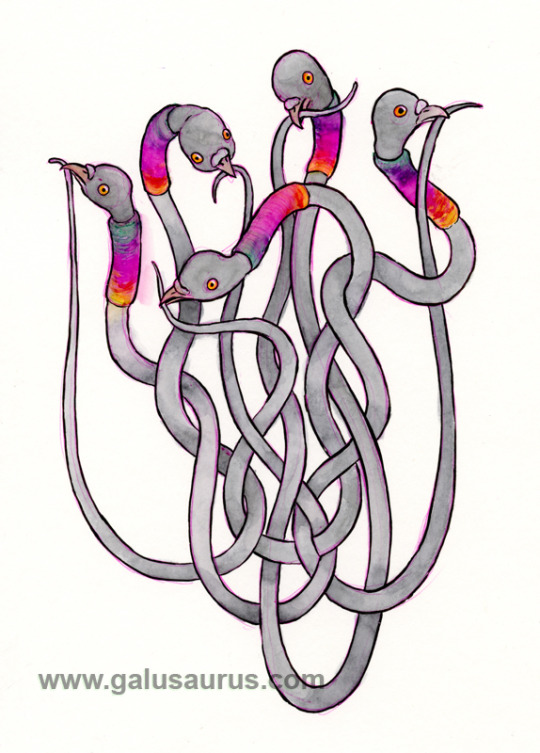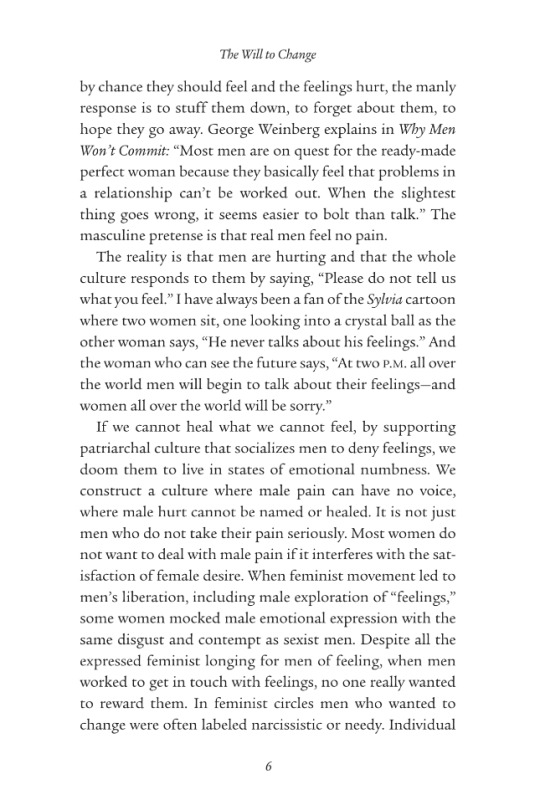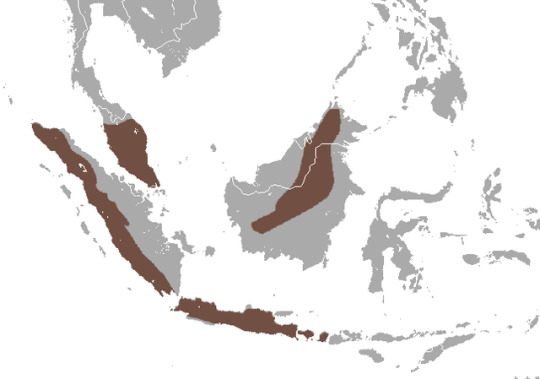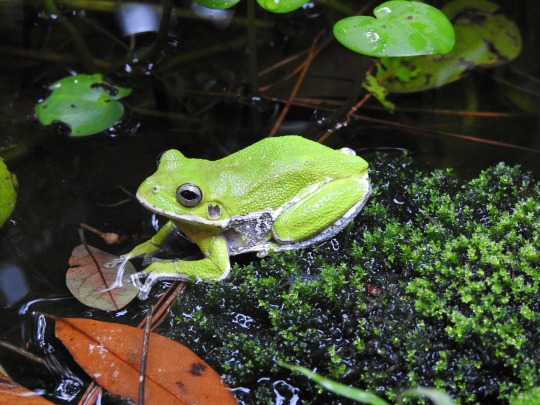Text
Weird MensLib Rant
I'm not sure where this is going, but I wanted to write down some of my thoughts concerning where men fit into the feminist movement.
The feminist movement is broad, with millions of people identifying at least partially with feminist ideas. Because of this, you are bound to run into quite a lot of different perspectives on topics like the role of men and boys in the movement.
The two competing perspectives we see are that feminism is fundamentally a gender equality movement and that dismantling societal expectations for men is inseparable from any attempt to achieve this goal, and the idea that feminism is a movement established by women and for women, and while men are important as allies, feminists should not be expected to extend resources to solving men's issues.
This creates a paradoxical situation wherein Men's Rights Advocates are discouraged from directly working with feminists as this is seen as drawing resources from a women's movement to solve men's issues; yet at the same time are discouraged from developing their own movements as they are seen as unnecessary when feminist movements already advocate for gender equality.
I think this leads to a vacuum in gender discussion which the right wing exploits. Of course, the right obviously is to blame for emboldening figures like Andrew Tate and facilitating the rise of the far-right incel movement; but I think as leftists we have contributed to the popularity of the right wing manosphere by failing to offer a significant alternative.
If feminism is truly a movement by women and for women, then men's participation in said movement becomes altruistic, or at least a moral obligation to assist others. While there is fundamentally nothing wrong with participating in movements for the good of others, it is important to evaluate how such participation appears from the perspective of men and boys.
One of the most common terms used to analyze men's behavior in the context of societal norms is toxic masculinity. I think a lot of people don't understand the definition in the original context. Toxic masculinity is a set of expectations placed on men that impact our behavior in ways that are ultimately restrictive and detrimental to ourselves and/or others. It is not the individual or even the behavior that is toxic, but rather, the social forces which promote the behavior.
One element of toxic masculinity is an expectation that men are providers, and that they are seen not for who they are, but for what they can do for others. From this perspective, men's expected role in feminist movements appears only to reaffirm this expectation of toxic masculinity.
Again, while it is great for people to dedicate themselves to uplifting others, holding an expectation that men engage in this task with out consideration of reciprocation may be seen as a form of toxic masculinity. Men and boys seeking to escape social expectations are not going to be attracted to a movement which appears to see them only as assets.
I do think that feminist activism has helped, and will continue to help, men's issues, but that is not the impression given at a glance by the movement at large. One of the most oft-talked about notions when discussing the development of the manosphere is the pipeline that young men fall into which leads them into alt-right circles.
There are a lot of factors contributing to this: social media algorithms which promote far-right content, the ability for far-right speakers to invoke passion in the audiences over seemingly trivial ideas, and a natural gravitation towards ideologies that hold that your groups are superior to others.
However, I feel that the left promotes this rabbit hole by failing to provide an adequate alternatives for men and boys. People searching for content relating to men's issues will be inundated with right wing media because left wing movements dedicated to men's issues seem scarce and lacking in support from fellow leftists.
There are of course movements like MensLib that offer leftist and progressive approaches for men's issues, but again, these movements are limited in popularity and support and do not have the necessary outreach to compete with the alt-right.
One of the most common complaints about the feminist movement (atleast among the terminally online) is the prevalence and refusal to condemn statements like 'men are trash' among the feminist community. The justification for this is that such statements are purely a form of venting and not meant in earnest as a way to demean men and promote violence against them, as is frequently the case for statements made by men directed against women.
While this is understandable, these statements are really hurtful. How can activists who claim to wish to abolish toxic masculinity expect men to stoically role with the punches and participate selflessly in feminist activism regardless?
Another criticism I have seen brought up when discussing feminist thought is this perception of hyper-agency among men. Men do not chose to embrace toxic masculine traits out of genuine desire; they do so because of societal expectations forcing their hand.
By characterizing the problems facing men as personal, actual activism is limited in its effectiveness. To quote another user:
Boys (and men) are notorious for repressing their emotions. They have a good reason: in boys' peer groups, a failure to control your emotions is almost as shameful as a failure to control your bladder; it is a sign of weakness, and any sign of weakness makes you a target for bullying and ridicule. So boys learn to wear a permanent mask of aloof toughness to avoid inadvertently revealing any sign of weakness or uncontrolled emotion, and many keep this habit into adulthood. It is generally well recognized that suppressing emotions is unhealthy in the long run, but it seems to me that the commonly proposed antidote is misguided: boys (or men) are told to "just open up more and be vulnerable" or to "learn how to cry", as if their reluctance to show emotions were some kind of irrational emotion-phobia, rather than a perfectly reasonable, perhaps even necessary, defense against the ridicule, contempt and loss of respect that society inflicts upon those who can't keep their emotions in check in the proper "manly" way.
Some feminists (not all, by any means), assume that men are in control of their own societal norms; that because men are the dominant sex in patriarchal tradition and are overrepesented among the elite, they must also posses the agency necessary to overcome these gender expectations without the need for a major social movement:
Problems predominantly affecting women are addressed by changing society, while those predominantly affecting men are addressed by changing men (or by telling men to change themselves). The difference is not that one approach is right and the other wrong; they are both 'right' in the sense that they highlight genuine issues, but the approach to men's problems is more superficial. When dealing with men's problems, we focus on the immediate cause, which is usually the men's failure to cope with mental strain ("he should have gone to therapy", "he should have learned to open up more"); in contrast, when dealing with women's problems, we focus on "the cause of the cause", and try to remove the systemic social issues causing the mental strain, rather than telling the victims what they should have done to better cope with it.
So to conclude this very long rant, I feel as though there exists a vacuum in progressive spaces for genuine men's rights activism that essentially leads to the left conceding the subject to the right. I hope that future feminist activism with develop to be more inclusive and consider the societal underpinnings of patriarchy and toxic masculinity and focusing on unraveling those as opposed to demonizing its victims.
28 notes
·
View notes
Text
Mutation March 2022 - day 26: Pigeon
Pigeons puff up and frogs puff up, therefore... frogeon.

Someone please feed this weirdo.

This angelic pigeon did not go as planned.

These early birds ARE the worms.

279 notes
·
View notes
Text
Look, I don't think any of us were ready for Leptobrachium ailaonicum

[img src]
5K notes
·
View notes
Text
..i have an idea. read until the end before you decide to laugh, please.
i wonder if the type of guy who yells “not all men!!” all the time is coming from a place of terrible self-esteem, and this is caused by the repression of emotions over the course of his life.
if you don’t feel good about yourself, it’s easy to take any criticism as a personal attack, even if it’s not even directed at you. because when you hear the critique of a group you’re part of, your brain immediately goes “SEE!? i TOLD you you were a piece of shit, and THAT’S WHY!!”
so naturally, your reaction is to jump on the defensive. you assume that since you’re the worst person in the world, the statement MUST be about you. nobody could possibly be worse than you, right? but hey, you’re NOT a bad person! how dare they act like you are!! it wasn’t me who did it, so stop accusing me!!
the fight inside your head gets projected outward and onto the person who just made the generalized critique.
i say this because i think that’s the root of it for me.
this could work for other groups too. we speak so often of toxic “masculinity” causing men to repress their feelings, but even being raised as a “girl,” i still got bullied for crying as a kid. it seems as though we’re all forced to hide our emotions for one reason or another, whether it’s because “boys don’t cry” or we’re “being such a girl [and that’s bad].”
in order to really put privilege AND criticism in perspective, we have to start with a healthy level of self-esteem.
now i definitely don’t want anyone to take away the message that we should never be angry or vent our frustrations. BUT, if we tell EVERY person that anger is the only way to achieve social justice, we’ll be cheating many people out of the other productive roles that they might be better at. we can’t all be “warriors” — somebody has to heal, counsel, rebuild, strategize, and so forth. so if your strength lies in some other area, don’t let anybody shame you into abandoning it because it’s “not angry enough.”
6 notes
·
View notes
Text
So I read this interesting post from the MensLib subreddit, about how men's issues are always blamed on men themselves and never on society. The post itself as well as the comments are a very good read in digging in to antimasculism & the ways in which feminism has failed to critically examine men's suffering under the patriarchy. For example (all bolding by me):
Here again, the problems predominantly affecting women are addressed by changing society, while those predominantly affecting men are addressed by changing men (or by telling men to change themselves). The difference is not that one approach is right and the other wrong; they are both 'right' in the sense that they highlight genuine issues, but the approach to men's problems is more superficial. When dealing with men's problems, we focus on the immediate cause, which is usually the men's failure to cope with mental strain ("he should have gone to therapy", "he should have learned to open up more"); in contrast, when dealing with women's problems, we focus on "the cause of the cause", and try to remove the systemic social issues causing the mental strain, rather than telling the victims what they should have done to better cope with it.
I think this is a great point, and something we really need to tackle. OP also goes on to talk about self-repression, comparing girls avoiding sexual harassment and boys avoiding bullying:
Boys (and men) are notorious for repressing their emotions. They have a good reason: in boys' peer groups, a failure to control your emotions is almost as shameful as a failure to control your bladder; it is a sign of weakness, and any sign of weakness makes you a target for bullying and ridicule. So boys learn to wear a permanent mask of aloof toughness to avoid inadvertently revealing any sign of weakness or uncontrolled emotion, and many keep this habit into adulthood. It is generally well recognized that suppressing emotions is unhealthy in the long run, but it seems to me that the commonly proposed antidote is misguided: boys (or men) are told to "just open up more and be vulnerable" or to "learn how to cry", as if their reluctance to show emotions were some kind of irrational emotion-phobia, rather than a perfectly reasonable, perhaps even necessary, defense against the ridicule, contempt and loss of respect that society inflicts upon those who can't keep their emotions in check in the proper "manly" way.
It's something we don't really question in mainstream feminism. Women's issues have a societal root, and men's issues are issues that men put on themselves, and therefore men just need to fix it themselves and change.
And while yes, we all have a responsibility to unlearn harmful societal teachings, just saying "men need to fix their shit" doesn't help anyone. I've been annoyed for a while at how people will react to men suffering under the patriarchy with "UGH they need to go to therapy", as if
Needing therapy is a sign of failure or a bad thing, and someone not going to therapy when they need to is them being an asshole on purpose and not potentially a sign of them not feeling safe enough to go to therapy, feeling too ashamed, not having enough money or time, etc.
Individual men getting individual therapy will solve the societal problems of forcing boys and men to repress their emotions and view themselves as only valuable if they can perform manual labor and have a lot of sex with women. It's a problem that is only perpetuated by men themselves and if they just stopped doing that, then the problem would disappear.
No self-respecting feminist would ever react to a woman obviously suffering from the patriarchy with "ugh, she needs to go to therapy and fix herself." Yes, therapy would be helpful most likely, but that's not going to actually fix the underlying cause of her issues. So why do we, as feminists, think that "men just need to fix themselves" is an okay response to societal suffering under the patriarchy?
Who does this help? Who benefits from us ignoring these issues? Why do we assume that men's experiences under the patriarchy are so one-dimensional and that we have no responsibility for unlearning our societal biases around men and masculinity?
Someone in the comments also added this quote from the "perpetually relevant" I Am A Transwoman. I Am In The Closet. I Am Not Coming Out essay by Jen Coates:
Have you noticed, when a product is marketed in an unnecessarily gendered way, that the blame shifts depending on the gender? That a pink pen made “for women” is (and this is, of course, true) the work of idiotic cynical marketing people trying insultingly to pander to what they imagine women want? But when they make yogurt “for men” it is suddenly about how hilarious and fragile masculinity is — how men can’t eat yogurt unless their poor widdle bwains can be sure it doesn’t make them gay? #MasculinitySoFragile is aimed, with smug malice, at men—not marketers.
And then another commenter left this (and referenced bell hooks' work on men!!):
"Do you agree that we tend to approach women's problems as systemic issues, and men's problems as personal issues?"
Yes, and there's even a name for this: Hyperagency. Individual men are assumed to be immune to systemic pressures because the people at the top of the hierarchies generating those pressures are also men.
"And if you do agree with that, do you think this difference in approach is justified, or do you rather think it is a case of an unfair bias?"
It's pretty clearly not rooted in reality. The idea that billions of ordinary men aren't beholden to the social constructs under which they were raised is just plain silly. I'd blame the empathy gap, but honestly I feel like it's more than that.
Patriarchy hyper-individualizes every struggle a man faces as a way to shield itself from critique and gaslight ordinary men. The motivations there are readily apparent. However, we see the same blind spot appear even in more academic Feminist spaces (taking for granted that "Feminist" spaces on social media are hardly representative of the cutting edge of Feminist thought). bell hooks once postulated that some Feminist women are deeply afraid of acknowledging how little they understand about men, let alone taking the steps to broach that gap.
Another person explained hyperagency by saying "Every single individual man is a hyper agent who is just expected to bootstrap his way out of the patriarchy through sheer force of will."
7K notes
·
View notes
Photo

bell hooks, The Will to Change: Men, Masculinity, and Love
8 notes
·
View notes
Text
BAT #1 🦇 🦇 🦇 🦇 🦇 🦇 🦇 🦇
Suborder: Yinpterochiroptera
Super family: Pteropodoidea
Subfamily: Cynopterina
Genus: Aethalops
Name: Pygmy fruit bat (Aethalops alecto)
Also known as the grey fruit bat, this little guy happily thrives in Peninsular Malaysia, Sumatra (island of western Indonesia) and Java (another Indonesian island). They like the forests!!! Specifically montane forests which are tropical and subtropical moist broadleaf forests, also known as a cloud forests!!! What cuties!!! There aren’t many and they have only been studied a couple times ever!! They weigh 0.5 oz 🥺🥺.





91 notes
·
View notes
Photo

A Barking Tree Frog (Dryophytes gratiosus)sits in a wetland in northern Florida, USA.
photograph by Dick Bartlett (used w/ permission)
383 notes
·
View notes
Text
Deity who's unacquainted with concept of evolution creating a world with, like, twelve different kinds of creatures, thinking "yes, that's a good number – nice and symmetrical", then going on vacation for a couple million years and being very upset at what's waiting for them when they get back.
53K notes
·
View notes
Text
obligatory welcome guide for redditors
A lot of the guides I've seen don't actually seem to understand how reddit works in comparison to tumblr so
your blog is basically your own small subreddit. some people curate this heavily to fit a theme, like a sub, most people don't
reblogs are culturally equivilant to upvotes but functionally equvilant to crossposting
there is an algorithm. it sucks and nobody uses it. turn it off in settings. everything is generally chronological
likes are functionally equivilant to saving a post
you've probably already seen this but change your icon and put something in your bio or people WILL assume you're a bot. personal info not required
generally, anything you would put as a comment on a thread should go in the tags or the replies of a post. only add comments in reblogs if you want it to become part of the base post
tags are mostly equivilant to flairs, used for organization and commentary
your dashboard is an aggregation of everyone you follow
there is an r/all equivilant(trending page) but it sucks and nobody uses it
our search also sucks. your best bet is using tumblr.com/tagged/[TAG] and not /search
there are no mods
by extension, reporting something doesn't put it in front of the mods, it sends it to staff, who may or may not do anything(usually they don't)
there is no karma, there are no karma limits. anyone can reblog anything, comment/reply to anything, or post in any tag
"reposting"(reblogging) old content doesn't matter. people can and will reblog the same post multiple times, including in a row
CAVEAT. reposting someones art(NOT reblogging, making a new post) is a dick move. i know this is commonplace on fandom subs but its not necessary here. everything you post should be [OC] unless you are reblogging. or posting shitty memes
we have our own sitelore, you'll pick it up
(though im not opposed to bringing some over from reddit)
our app also sucks. we do not have third party apps and any that claim to be are scams. sorry
for desktop, most people use the XKit Rewritten extension for QoL improvements and to revert shitty aesthetic updates, much like old.reddit
we have no idea where the porn rules are at either. add a mature content flag to anything you'd get fired for looking at at work, that's about it
finally, from the bottom of my heart, fuck u/spez
30K notes
·
View notes
Text
Ea, Our Second Chance (14)
14. Reproduction of Haematophyta
(Index)
(< 13. Species study: anatomy of Diplostomia)

(full image)
« You already know that all the cells of your body, no matter how different they look, have all the same genes. Brain cells, liver cells, skin cells, muscle cells, they’re all genetically identical. This is also true in Ean animals. But not in Ean plants! In fact, almost every red plant you see growing, from your backyard to the thickest jungle, is actually what scientists call a chimera: a mixture of two kinds of cells that have different genes, even though they might look the same under a microscope.
The body of a red plant is made of many different tissues: the outer rind, the inner pulp, the hydraulic vessels, and so on. Each tissue is made up of specialized types of cell. However, a flat cell of the rind might share all its genes with a very different-looking storage cell of the pulp, but not with an identical-looking flat cell right next to it! So the two kinds of cells with different genes, which are called gamotypes, are all mixed together, and they both take all the shapes that are necessary for the plant’s life processes.
What’s the point of having cells with two different gene sets, if each alone can do all jobs? Scientists think it’s to make harder for germs to spread inside the plant’s body. Cells of the two gamotypes mount slightly different defenses against invaders.
How is it possible for a red plant to reproduce, then? The tissues of the plant release special ciliate cells, called gametes, produced from both gamotypes, that meet and fuse in the plant’s circulatory system. This is like sperm cells fertilizing an egg, except that the gametes look identical. If two gametes of the same gamotype fuse, the resulting cell dies and is digested. If the gametes are of two different gamotypes, than the resulting cell is a hybrid with genes from both gametes (the excess PNA is also digested). But this is not always the case.
Isn’t God’s creation marvelous? Hypotheses based on Fracturist ideas would predict that one gamotype would put all its energy into producing gametes, so that its genes are more represented in the propagules. This would force the other to produce vital tissues and throw away most of its fitness, or else to respond in kind, which would turn all plants in shapeless masses that do nothing but split. So it would be impossible for Ean plants to evolve complexity: at best, they could aspire to be red slime, just like their bacterial ancestors! Their example teaches us a beautiful lesson about humility and cooperation.
Hopefully many such fusions occur, but one is enough. The hybrid cell divides and forms a slimy mass that circulates freely in the plant (this is what parasol tree syrup is made of). When it reaches the reproductive organs of the plant, which are usually called bulbs, or simply the plant’s surface if there’s no such organ, then the mass comes to the surface. This is the new baby plant that comes out, in liquid form, from the parent. Usually it forms droplets or soft buds, each of which might break off and become a propagule.
The first red plants on land simply let their propagules drip to the ground or be washed down by rain, while their aquatic ancestors let them go into the water. Others, like the tallest candlesticks, make a kind of foam that the wind carries away. Many use animals for dispersal, making a kind of glue that sticks on their bodies as they pass through, like the beartrap plant, or as they feed on a sweet liquid part of the propagule that resembles nectar. Sometimes all the bulb is sweet and edible, like the “fruits” of the yellow nopal, which people eat as well (in the wild, kirikits break them off and leave propagules everywhere on their way back to the nest). Spongegrass sticks its propagules under the feet of animals that trample it. In some species, bulbs break open on their own (this is called dehiscence) to scatter propagules as far around as possible. For example, the bulbs of the sneezing tree burst when its root hairs feel motion nearby.
One way or the other, the propagules reach the right ground. There they release substances that attract other propagules produced by different plants of the same species. Since they are mostly liquid, the propagules can crawl on their own like amoebae or colloplasms (remember those? Look again at chapter 6 if you don’t). When they finally meet, they mix their bodies. Whereas the sperm and egg cells of Earth’s animals fuse and put their genes together before they grow into a new organism, the reproductive cells of red plants stick to each other without fusing, and form a chimera.
It’s not always this way. Sometimes, three or four propagules meet and form a chimerical plant with three or four types of cells. Scientists once found a fan tree with at least nine kinds of cells in a very dense part of the Oshun Jungle. Sometimes, instead, a propagule founds no one to merge with, or finds only mates from the same parent, and grows into a plant by itself. This plant is non-chimerical, and all its cells have the same genes. Some species, like Jankowski’s menorah tree, do this on purpose. Non-chimerical plants grow fast when there is plenty of room and light, but it’s hard for them to defend against germs when they start crowding. More rarely, propagules from different species can meet. If they are closely related species, the chimerical plant can stil grow up healthy, but it almost never manages to reproduce because its gametes do not fuse well. »
– Green and Red: Introduction to Compared Biology for Primary Schools (11th edition), Ministry of Education, Olduvai, 299 AL
This is precisely the sort of nonsense…
Keep reading
28 notes
·
View notes













